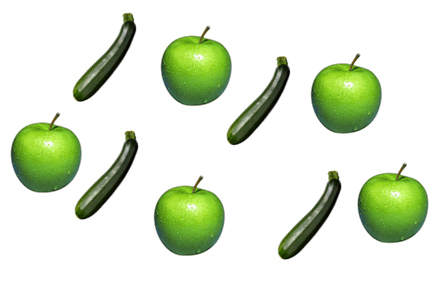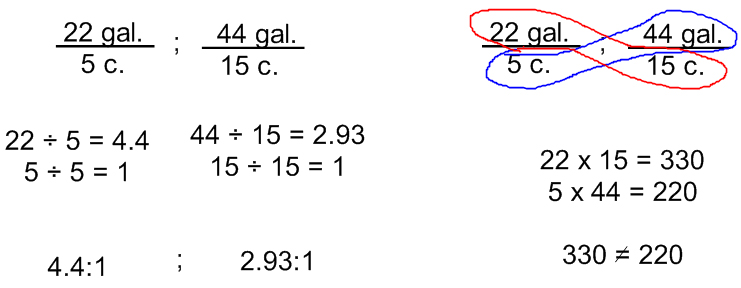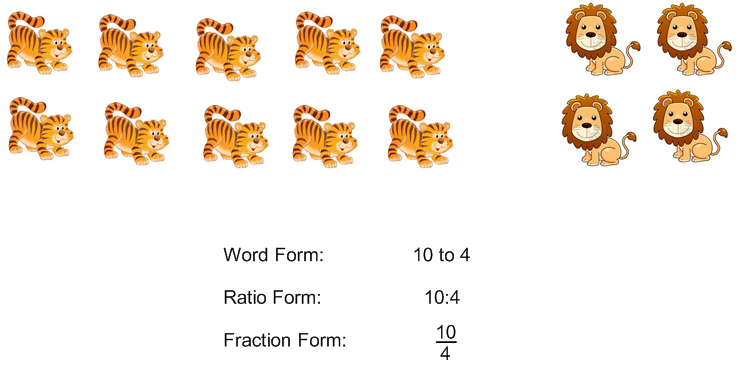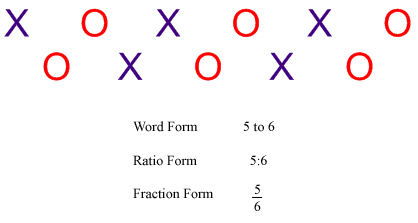Topics
1. Test Corrections
2. Unit Pretest
3. Understanding Ratios and Equivalent Ratios
4. Unit Rates
5. Understanding Proportions
Understanding Ratios and Equivalent Ratios
A ratio is a comparison between the amount of two different things. It is probably the concept we cover in sixth grade that is used the most throughout our lives. Miles per hour, dollars per pound, etc.
Study the picture below.
 Looking at the picture, we can all agree that there are 5 apples and 4 zucchini. If we were asked the question,”What is the ratio of apples to zucchini?” The response comes entirely from those numbers. It would be 5 to 4. Notice that the first object asked was apples, so the first number I put is the number of apples. Another of the basics for ratios is knowing that there are three different ways that we can write them. I have already shown you the first, we can use words, “5 to 4″. We can also write it, replacing the word to with a colon. It would look like this “5:4″. Finally, we can write it as a fraction “5/4″.
Looking at the picture, we can all agree that there are 5 apples and 4 zucchini. If we were asked the question,”What is the ratio of apples to zucchini?” The response comes entirely from those numbers. It would be 5 to 4. Notice that the first object asked was apples, so the first number I put is the number of apples. Another of the basics for ratios is knowing that there are three different ways that we can write them. I have already shown you the first, we can use words, “5 to 4″. We can also write it, replacing the word to with a colon. It would look like this “5:4″. Finally, we can write it as a fraction “5/4″.
Here is another example. Count the number of x’s and o’s. The ratio of x’s to o’s is 5 to written in its three forms is shown below.
The other part of this lesson is equivalent ratios. Equivalent ratios works in the exact same way that equivalent fractions did. We could multiply or divide it, so long as we do the same thing to both numbers. Let’s take this ratio of tigers to lions.
This ratio tells me that for every 10 tigers there are 4 lions. This means if I have 20 tigers, meaning I multiplied the number of tigers by 2, I would have 8 lions, also multiplied by 2. So an equivalent ratio 10 10:4 could be 20:8. I could also multiply them by 3, 30:12, or 4, 40:16. This could continue going on for however long we wanted, and so long as multiply both numbers by the same thing, it will be an equivalent ratio.
As I previously said, we can also divide them. Just like fractions have a simplest form, ratios do as well. If we take the ratio of 10 tigers to 4 lions, we can use our cake method to reduce it to its simplest form, just as we did with fractions.
 So, if there are 10 tigers to every 4 lions, then we can reduce that to there being 5 tigers for every 2 lions.
So, if there are 10 tigers to every 4 lions, then we can reduce that to there being 5 tigers for every 2 lions.
Unit Rate
A unit rate is simply a ratio where the second number in the comparison is one. 65 miles per hour, is a unit rate because it is 65 miles per one hour. $2.50 per pound, is a unit rate because you would pay $2.50 for every pound that you purchased. Finding an equivalent ratio, which was covered in the previous lesson, is how you would find the unit rate. To get the second number down to one, you would have to divide it by itself. Remember, whatever you do to one number, you would have to do to both. So let’s say a family goes on a road trip.
 The dad keeps a measure of his gas mileage. He knows that he got 120 miles for 10 gallons of gas. To convert this into a unit rate, we have to make the second number a 1. To do that, we have to divide 10 by 10. If we divide the 10 by 10, we also have to divide the 120 by 10, so we would know that he got 12 miles per gallon. Here’s another example outside of a story problem:
The dad keeps a measure of his gas mileage. He knows that he got 120 miles for 10 gallons of gas. To convert this into a unit rate, we have to make the second number a 1. To do that, we have to divide 10 by 10. If we divide the 10 by 10, we also have to divide the 120 by 10, so we would know that he got 12 miles per gallon. Here’s another example outside of a story problem:
 We can see from the above math that if a student reads 45 pages in 30 minutes, she is reading at a speed of 1.5 pages per minute.
We can see from the above math that if a student reads 45 pages in 30 minutes, she is reading at a speed of 1.5 pages per minute.
Understanding Proportions
Proportions are formed by two equal ratios. Using the examples from the previous lessons, 45 pages:30 minutes would form a proportion with 1.5 pages:1 minute because they are equivalent ratios; 10 tigers:4 lions would form a proportion with 20 tigers:8 lions. In this lesson, you will be asked to identify if two ratios form a proportion. Take a look at the ratios below:
There are two different ways we could evaluate those ratios to see if they form a proportion. The first is to simplify them both to a unit rate.
 You can see from the above math that both of those ratios reduce down to the unit rate of 4:1. Therefore the two of them do form a proportion. the other way we could test this is by using a method called cross-multiplication. To do this, you multiply the top number of one side of the proportion by the bottom number of the other side of the proportion. Look at the same proportion as it is evaluated using cross-multiplication.
You can see from the above math that both of those ratios reduce down to the unit rate of 4:1. Therefore the two of them do form a proportion. the other way we could test this is by using a method called cross-multiplication. To do this, you multiply the top number of one side of the proportion by the bottom number of the other side of the proportion. Look at the same proportion as it is evaluated using cross-multiplication.
 Again, you can see that 20 x 10 and 5 x 40 both equal 200, so those two equivalent ratios form a proportion. Here is one more example of both methods:
Again, you can see that 20 x 10 and 5 x 40 both equal 200, so those two equivalent ratios form a proportion. Here is one more example of both methods:
 The final thing you’ll need to be careful of is probably the most simple. If there are units, such as the example pictured above, you need to be certain that the units on the top of both proportions is the same, and the units on the bottom of both proportions is the same, as shown above. Below is a non example of this. you’ll notice on the top of one is miles and the bottom is seconds. It is reversed on the other, and because the tops and bottoms of both are not the same thing, it does not form a proportion.
The final thing you’ll need to be careful of is probably the most simple. If there are units, such as the example pictured above, you need to be certain that the units on the top of both proportions is the same, and the units on the bottom of both proportions is the same, as shown above. Below is a non example of this. you’ll notice on the top of one is miles and the bottom is seconds. It is reversed on the other, and because the tops and bottoms of both are not the same thing, it does not form a proportion.




